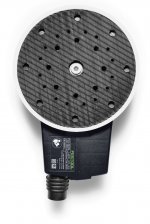Cheese
Member
Brent Shively said:The sanders are not exactly the same.
The shaft on which the pad mounts is different in two ways.
1. The 6" is keyed differently and won't accept a 5" pad.
2. The length of the shafts are different.
The pad of the 6" will fit on the 5" machine, but the length of the shaft for the 5" machine is different as well as the height of the backing plate of the pad itself . Due to this height difference the pad brake will not engage properly even though the pad brake is the same for each machine.
Brent
That's interesting...seems like Festool entered a race and when they got within 50 feet of the finish line, they decided to quit. [eek]
I'd chalk this one up to missed opportunity.

